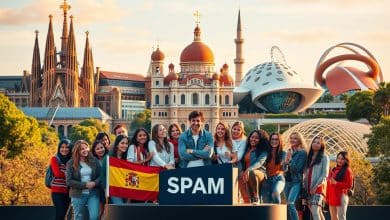Postgraduate Scholarship Opportunities for Spanish Graduates
Many Spanish graduates will seek pathways to continue their education and gain global experience. This guide highlights key options that help students reduce costs and expand career horizons.
Competitive awards such as Fulbright, Chevening, Erasmus Mundus, DAAD, Rotary, Australia Awards, and the Swedish Institute offer full or partial funding for master’s and doctoral study. Each program has distinct deadlines, target fields, and selection criteria.
Readers learn how to match an international scholarship to their goals, plan application timelines, and compile strong documents. The section explains how grants, tuition waivers, and institutional aid can stack to cover tuition and living costs.
This concise introduction points students to specialized pathways in STEM, public policy, and global health. It sets the stage for a practical roadmap to shortlist opportunities, monitor deadlines, and prepare competitive applications for study abroad.
Why Spanish Graduates Should Target International Scholarships for Future Study
Targeting international funding can transform a Spanish graduate’s academic goals into real-world opportunities. These awards give access to research labs, mentors, and networks that matter for thesis and career progress.
Benefits for graduate students: career mobility, research access, and funding
Global awards often include stipends, tuition support, and travel. That funding reduces financial strain and raises a graduate’s profile for future grants.
Recipients join cohorts that provide mentorship and alumni links. Those networks boost career mobility and internship paths for international students.
Aligning degree goals with destination country strengths
- Choose the UK for policy and humanities; Germany for engineering and research; EU consortia for multi-campus master’s programs.
- Programs such as Fulbright, Chevening, Erasmus Mundus, and DAAD place students in strong research environments and career pipelines.
| Program | Focus | Typical Benefit |
|---|---|---|
| Fulbright U.S. Student | Study or research in 140 countries | One-year grants; research or ETA roles |
| Chevening | One-year master’s in the UK | Tuition support, leadership network |
| Erasmus Mundus / DAAD | Multi-country masters / German grad training | Consortium degrees; research institution access |
How to choose study destinations and programs that maximize funding
A clear match between a student’s field and a country’s research priorities boosts chances for funded study. That fit matters more than prestige alone. It guides where to apply and which program will fund research, tuition, or living costs.
Matching field of study with national priority areas
Germany supports many engineering and applied sciences fields through DAAD. Erasmus Mundus Joint Masters link consortia across Europe, opening cross‑campus resources. The Swedish Institute emphasizes leadership and impact, while VLIR‑UOS backs English‑taught master’s training in Belgium.
Language considerations and preparatory pathways
Many master’s programs teach in English, but adding intensive language courses helps admissions and funding outcomes. Students who plan to study abroad should list language steps in their application.
University, college, and association partnerships to increase awards
Look for departmental ties, research labs, and association networks that nominate candidates or offer co‑funding. Verify whether a program waives tuition and then stack aid from the host and external sources.
“Aligning a degree with national research goals often makes a student’s application stand out to funders.”
- Map your field to country strengths.
- Check consortia and partnership pathways.
- Confirm eligibility for international students before applying.
Postgraduate scholarships abroad: top global programs to bookmark
Ambitious graduates should bookmark a short list of international awards that match their field and timeline.
Key programs offer clear tracks, reliable deadlines, and strong alumni networks. Each program targets different goals — research, teaching, or multi‑campus master’s study.
Fulbright U.S. Student Program
Fulbright supports Study/Research and English Teaching Assistant tracks. Deadlines vary by campus, typically August–October. Awards cover one academic year in 140+ countries and provide mentor networks.
Chevening Scholarships
Chevening funds one‑year master’s degrees at UK universities. The program emphasizes leadership and professional impact. Annual deadlines close in November.
Erasmus Mundus Joint Masters
Erasmus Mundus delivers EU‑funded consortium degrees with mobility across campuses. Applicants usually apply by January. Awards vary by program and often include tuition and living support.
DAAD (Germany)
DAAD offers a wide portfolio for master and PhD candidates. Deadlines vary by award. Benefits can include monthly stipends, tuition coverage, and university placement support.
“Plan early, contact supervisors or coordinators, and map deadlines to build a competitive application.”
| Program | Focus | Typical Benefit | Typical Deadline |
|---|---|---|---|
| Fulbright U.S. Student | Study/Research; ETA | One academic year; placement and networks | Aug–Oct (varies) |
| Chevening | One‑year master’s (UK) | Full funding; leadership network | November |
| Erasmus Mundus | Joint master’s / PhD consortia | Mobility; tuition and stipend varies | January (typical) |
| DAAD | Masters and PhD in Germany | Monthly support; research ties | Varies by program |
Grants and fellowships for research-focused master’s and PhD candidates
Research-focused grants let graduate students turn a clear question into a funded project with measurable impact. These awards prioritize a strong methodology, host mentorship, and realistic timelines for one year of work.
Fulbright research tracks and host-country options
Fulbright supports research in 140+ countries for one academic year. Successful applications show host affiliations, ethical approvals, and a compact plan that fits the award period.
Rotary Foundation Global Grants and development fields
Rotary Global Grants provide roughly $30,000 for master’s-level study or research in areas like peacebuilding, disease prevention, water and sanitation, maternal and child health, education, and community development.
The American Association of University Women (AAUW) funds more than $3 million annually through 200+ fellowships and grants, supporting women in graduate study worldwide.
“Applicants should pair a clear project plan with host letters and a realistic budget to compete for research funding.”
| Funder | Focus | Typical Support | Fit for Students |
|---|---|---|---|
| Fulbright U.S. Student | Individual research; host placement | One-year grant; placement support | Method-driven projects with host mentors |
| Rotary Foundation | Development fields (health, water, peace) | ~$30,000 for master’s coursework/research | Projects with measurable community impact |
| AAUW | Graduate women’s research and study | $3M+ across 200+ fellowships | Women pursuing thesis or professional degrees |
Country-specific awards with full or substantial tuition coverage
Several country-level awards deliver generous tuition support and clear pathways for international study. These programs often combine tuition remission with living stipends, health insurance, and pre-departure briefings.
Australia Awards Scholarships for graduate study
Australia Awards Scholarships, run by the Department of Foreign Affairs and Trade, cover full-time study at participating universities. They fund bachelor, master, and PhD degrees depending on the stream.
Coverage and deadlines vary by award. Applicants should check country-specific pages for intake dates and required documents.
Swedish Institute Scholarships for Global Professionals
The Swedish Institute funds roughly 300 scholarships annually for master’s study. Typical benefits include tuition fees, living expenses, and insurance, with an emphasis on leadership and societal impact.
VLIR‑UOS for master’s programs in Belgium
VLIR‑UOS backs English-taught training and master’s programs at accredited Belgian institutions. Awards target candidates from 31 eligible countries in Africa, Asia, and Latin America.
“Early alignment with a host university and clear post-study plans strengthen a candidate’s chance for a country-level award.”
- Confirm eligibility by country and degree level before applying.
- Tuition coverage differs: full remission, partial fees, or combined stipends and insurance.
- Check return-to-country or development-oriented obligations tied to some awards.
- Compile admissions offers and language proofs early to meet nomination rules.
Language-intensive programs that enhance scholarship competitiveness
Intensive language training can fast-track a student’s access to archives, fieldwork, and competitive awards. Short, immersive courses strengthen applications for study and research in languages that matter to a field.
Critical Language Scholarship (summer immersion)
The Critical Language Scholarship (deadline: November) offers fully funded summer institutes in 15 critical languages. This program gives students concentrated classroom time and cultural immersion.
Students return with measurable gains that improve prospects for a graduate application or competitive award the following year.
Boren Awards for strategic language study
Boren Awards fund study of less‑commonly taught languages in world regions important to U.S. interests. Administered by the National Security Education Program, Boren favors long‑term commitment to language and regional expertise.
“Language proficiency unlocks primary‑source research, faculty access, and field placements that elevate an application.”
- Align target languages with archival or fieldwork needs to show clear academic impact.
- Document prior coursework or immersion to demonstrate readiness for accelerated progress.
- Plan summer intensives into a multi‑year study timeline to meet spring and fall application cycles.
Field-driven funding: STEM, public policy, and global health
Funding that targets specific fields can make an application stand out to major national and international programs. Aligning a project with these priorities helps students connect to labs, policy units, and health partnerships that host funded work.
Leveraging national and international program priorities
Programs like Fulbright support research across disciplines, while Rotary Global Grants back master’s‑level projects in development fields. NIH Fogarty fosters global health partnerships, and the National Science Foundation funds international research and training in STEM.
“Tailor proposals to a program’s strategic themes and define measurable impact from the start.”
- Target climate resilience, AI/data science, health systems, or governance reform to match funder priorities.
- Show interdisciplinary plans—e.g., engineering plus policy—to increase appeal to programs and grants.
- Secure partnerships with labs or ministries to demonstrate feasibility and access to resources.
| Funder | Field Focus | Typical Support | Best fit for students |
|---|---|---|---|
| Fulbright | Research & teaching | One‑year grant, placements | Method‑driven proposals with host mentors |
| Rotary Global Grants | Development fields | Master’s project funding (~$30,000) | Community impact and applied projects |
| NIH Fogarty | Global health research | Partnership grants and training | Health systems and translational research |
| NSF | STEM research & education | International collaboration grants | Data‑driven and interdisciplinary STEM projects |
Application timelines and the academic year cycle to plan ahead
Planning timelines around the academic year helps students avoid last‑minute hurdles when applying for major awards. A clear calendar lets them schedule tests, gather references, and request campus endorsements well before deadlines.
Typical fall, spring, and academic‑year deadlines
Many marquee programs cluster their windows in the fall, with selections often announced the following spring. Fulbright runs August–October (varies by campus), Chevening closes in November, and Erasmus Mundus typically closes in January.
Language programs such as CLS close in November for summer institutes, while Gilman posts deadlines in March and October. Providers like SIT, CEA, and USAC follow seasonal cycles with spring, summer, and fall intakes.
- Build a 12–18 month calendar that backdates testing, references, endorsements, and visa steps.
- Use spring to finalize research alignments, host contacts, and language plans ahead of fall rounds.
- Keep contingency dates for transcripts, statements, passport renewals, and recommendation follow‑ups.
- Coordinate college or university internal nomination deadlines for campus‑endorsed awards.
- Review renewal or deferment rules in case program start dates shift from year to year.
“Treat the academic calendar as the backbone of every application plan.”
Eligibility essentials: who scholarships are open to and how “students must” qualify
Understanding who qualifies lets students focus effort on programs where they stand a real chance. Eligibility rules define the degree level, experience, and documentation a candidate needs. Read criteria closely to avoid wasted time.
Academic level, degree objectives, and professional experience
Most awards target a specific degree and level. For example, Chevening targets graduate‑level master’s candidates with leadership potential. Fulbright U.S. Student includes recent graduates and young professionals for one‑year placements.
Selection panels look for clear degree objectives. A concise plan that links research or coursework to host resources improves chances. Professional experience can strengthen an application, especially for leadership‑focused programs.
Financial need, merit, and leadership criteria
Many awards combine merit and need. Committees weigh grades, research promise, and leadership activities. Some programs, like AAUW, prioritise graduate women and may review both merit and need.
- Scholarships are typically open at specific academic levels, so students must verify requirements before applying.
- Selection committees assess feasibility of a study plan and evidence of impact.
- Language tests and credential equivalencies are common; international students should document them early.
- Check nationality, residence, or field rules to confirm whether a scholarship open category includes an applicant.
“Clear objectives and documented eligibility make an application far more competitive.”
Documents that win awards: from personal statements to referees
Carefully crafted documents help reviewers see a student’s fit and impact quickly. Clear, concise materials make it easier for panels to assess why a candidate should receive an award.
The American Association of University Women (AAUW) distributes over $3 million a year in fellowships and grants. Their panels look for precise goals, measurable outcomes, and tight narratives that link a student to a host university and program.
- Personal statement: show intellectual trajectory, motivation for study, and why the chosen host country and program fit.
- Research proposal: state questions, methods, timeline, and expected outputs that align with host capacity.
- Referees: brief them early; ask for comments on rigor, leadership, and resilience.
- CV: tailor it—publications, projects, languages, and measurable outcomes matter.
- Grants/budgets: add a realistic budget and note any co‑funding or college support.
“Proofread meticulously and keep narratives consistent across essays, forms, and reference letters.”
Use university writing centers or fellowship offices for feedback and mock interviews. Align documents with selection rubrics and past awardee profiles to sharpen a competitive edge.
Funding stack strategies: combining grants, tuition waivers, and university aid
A layered funding approach helps students cover tuition, living costs, and unexpected research expenses. Start by cataloguing all possible university offers, then add external funding to close gaps.
Using host-university scholarships alongside international scholarships
Many programs allow a tuition waiver or assistantship plus an external grant. Examples include DAAD monthly support for degrees in Germany, Swedish Institute coverage for tuition and living, and Rotary Global Grants that co-fund projects with host institutions.
Students should verify whether two awards can be combined. Some awards forbid stacking funds that cover the same costs.
- Begin with institutional offers—tuition waivers, assistantships, or merit awards—then layer external grants to fill remaining needs.
- Map a simple funding matrix: tuition, fees, housing, insurance, travel, and research costs. Assign each award to specific lines.
- Explore department and college awards for flexible research funds that complement larger scholarships.
- Coordinate timelines so each award activates before program start and visa deadlines.
- Keep smaller grants as contingency to handle currency shifts or unplanned expenses.
Maintain clear records with the university financial office to avoid over-award issues and ensure compliance.
Where to find scholarships and keep opportunities “open” for the future
Finding reliable portals and campus networks makes it easier to spot new awards as they appear.
Official portals and campus networks
Start with flagship portals: Fulbright U.S. Student, Chevening, Erasmus Mundus catalogs, DAAD, the Swedish Institute, VLIR-UOS, and Rotary Foundation pages. These sites list current terms and seasonal deadlines.
Use a college or university fellowship office for curated lists and alumni contacts. Provider platforms such as SIT, CEA, and USAC publish program notices and targeted support for students studying overseas.
Shortlisting tools and alert systems
Build a shortlist by eligibility and field fit, then set email alerts so available students don’t miss new calls. Tag each entry by type: tuition, stipend, travel, or research.
- Maintain a live spreadsheet with contacts, deadlines, and status.
- Sync alerts to home and host academic calendars to prevent clashes.
- Validate details on official sites annually and join alumni webinars for insider tips.
“Centralize sources, set alerts, and keep alternative pathways open to protect future options.”
Conclusion
Spanish graduates can turn careful planning into funded study pathways that open global careers. A disciplined, year-based calendar—backdating tests, references, and endorsements—matches cycles such as Fulbright (Aug–Oct), Chevening (Nov), Erasmus Mundus (Jan), and CLS (Nov).
Combine grants with tuition waivers and university aid, verify stackability, and add language training to strengthen research feasibility. Top options include DAAD, Rotary (~$30,000), the Swedish Institute, and Australia Awards for varied coverage.
Strong statements, tight research plans, and timely referee letters make applications competitive. International students should refine shortlists, check eligibility, and use alumni portals to keep opportunities open. With alignment and persistence, a study abroad scholarship can fund a master degree and unlock global opportunities.
FAQ
What funding options exist for Spanish graduates planning further study overseas?
Why should Spanish graduates target international awards for their next degree?
How can applicants choose destinations and programs that increase chances of funding?
Which global programs should applicants bookmark first?
What fellowships and grants target research-focused master’s and PhD candidates?
Are there country-specific awards that cover most tuition and living costs?
Which language-intensive programs help strengthen an application?
How do field priorities like STEM, public policy, and global health affect funding chances?
When should applicants begin preparing for scholarship deadlines?
What are the common eligibility essentials for these awards?
Which application documents most influence selection decisions?
Can applicants combine multiple sources of funding?
Where can Spanish graduates find current opportunities and alerts?
Published on: 17 de August de 2025







